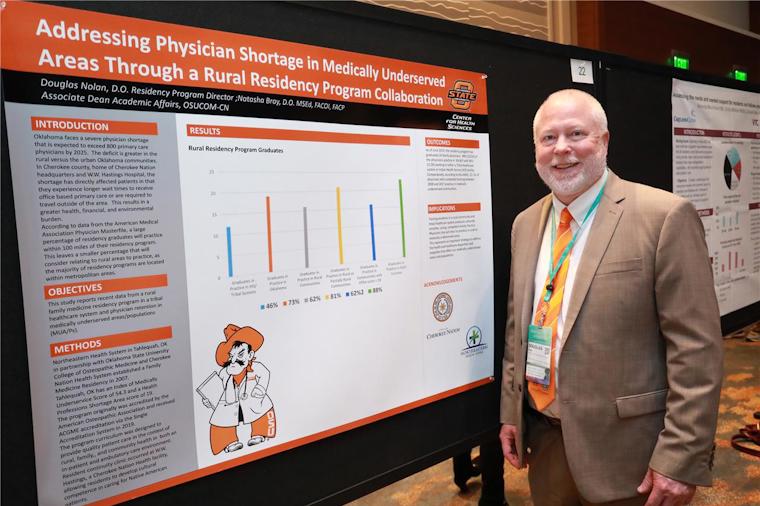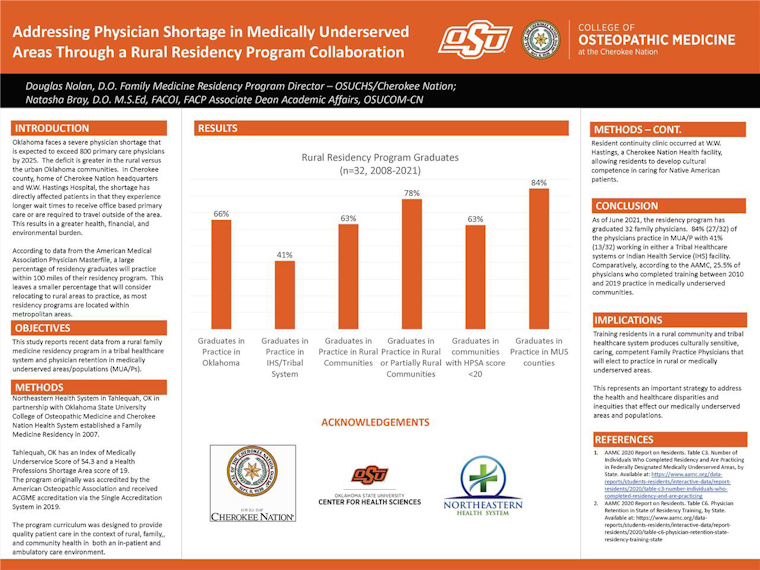Stories from the Field: Addressing Physician Shortage through a Rural Residency Program
In fulfillment of its mission to “improve health care and population health,” the ACGME seeks to address health and healthcare disparities and inequities that affect medically underserved areas and populations (MUA/Ps) by facilitating the development of ACGME-accredited programs in MUA/Ps. The ACGME’s accreditation framework for MUA/Ps aims to enhance physician workforce development in communities that face substantial shortages of practicing physicians in various clinical specialties. The following interview from the 2020 Annual Educational Conference (unable to be posted due to the onset of the COVID-19 pandemic following the conference in March 2020), updated as of July 2021, is an example of program efforts reflecting this goal.
Overview:
Oklahoma is facing a physician shortage, and the disparity is even greater in the state’s rural areas. In Cherokee County, the shortage has led to longer wait times, or the need to travel outside of the area—to conditions that lead to greater health, financial, and environmental burden. In the poster, Addressing Physician Shortage in Medically Underserved Areas through a Rural Residency Program Collaboration, Dr. Douglas Nolan explored how osteopathic physician residents may be able to bridge that gap in care as they complete their education.
Primary Author Name: Douglas Nolan, DO
Co-Author Name: Natasha Bray, DO, MSEd, FACOI, FACP
ACGME: Tell us about your academic and professional role.
Nolan: I am the Oklahoma State University Cherokee Nation Family Medicine Residency Program Director.
ACGME: Can you briefly describe your project for us?
Nolan: Training residents in a rural and/or tribal community may be a solution to attracting physicians to working in medically underserved areas. Oklahoma faces a severe physician shortage that disproportionately effects our rural and tribal communities. A family medicine residency program was established in 2007 in the rural community of Tahlequah, Oklahoma— the capital of the Cherokee Nation. This project examined the practice location of the graduates from 2008-2017.
ACGME: What inspired you to do this project?
Nolan: I was reading recent articles that detail the physician shortage primarily in medically underserved areas. It is known that most physicians will practice in close proximity to where they complete their residency training. However, the majority of graduate medical education occurs in urban communities. We wanted to investigate if training physicians in a rural and tribal community would result in physician retention in these underserved environments.
ACGME: What did you discover?
Nolan: We discovered that a large percentage of the graduating residents are currently working in medically underserved areas. As of June 2021, 32 family medicine physicians have graduated from the program. Twenty-one physicians (66 percent) are practicing in rural Oklahoma and 27 (84 percent) of the physicians are serving medically underserved communities. Thirteen physicians (41 percent) are working in either a tribal health care or IHS center in Oklahoma.
ACGME: What was the main takeaway?
Nolan: Educating residents in rural areas may be a solution to attracting physicians to medically underserved areas. Given the difficulty to recruit and retain physicians in rural and underserved communities, increasing education opportunities in these environments represents an important strategy to address physician shortages and maldistribution.
ACGME: Who could benefit from this?
Nolan: There are implications for future programs, collaborative efforts, and grant programs for exploring solutions to physician shortages in medically underserved areas.
ACGME: Any additional follow-up plans?
Nolan: The graduates will need to be followed to determine if the physicians stay long term in these areas. We plan to continue to track the career trajectories of the graduates to determine if they remain in these communities throughout their careers.
Learn more about the ACGME’s framework for medically underserved areas and populations, including initiatives to support GME expansion in rural areas such as the ACGME Rural Track Program designation.




